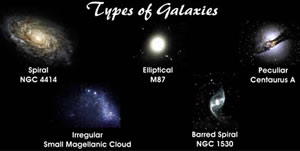Difference between Galaxy and Milky Way
Key Difference: A group of numerous stars, dust, planets and other interstellar matter, tied together by a gravitational force is known as a Galaxy. Milky Way is a Galaxy that comprises of our solar system.
Stars, planets, universe, all these words generate a lot of curiosity and research areas related to them are always evolving and expanding as this whole Universe. Galaxy and Milky Way are two such words that always make us feel that our world is just like a tiny particle in context to the whole Universe. Milky Way is the name that is given to the Galaxy that consists of our solar system. Let us understand these both terms.
An astronomical ecosystem comprising of stars, dust, planets, and other interstellar matter is known as a Galaxy. It is held together by its own gravitational force. Galaxies are considered to be the basic units of cosmic systems. Two basic Galaxy types are:-
 Spirals: These types of galaxies are little flattened and the ellipsoidal systems are supported by the random motions exhibited by the stars. In these kinds of galaxies, the disk contains stars, planets, dust and gas. They all rotate around their galactic centres and in a regular manner.
Spirals: These types of galaxies are little flattened and the ellipsoidal systems are supported by the random motions exhibited by the stars. In these kinds of galaxies, the disk contains stars, planets, dust and gas. They all rotate around their galactic centres and in a regular manner.
Ellipticals: They have comparatively more flattened disks and are also supported by the rotation. These are also known as disk galaxies. Giant elliptical galaxies are considered to be about two million light years long.
In addition to these main galaxies, other galaxies are referred to as irregular galaxies. The shape of this type of Galaxy is very different from elliptical and spiral and lack any regular form or structure.
The total luminosity of a Galaxy can be directly related with the total number of stars that are present in the Galaxy. Galaxies radiate a continuous spectrum of energy and thus, these spectrums are highly useful in understanding the galaxies. There are uncountable galaxies that exists in the Universe that is known to us. Galaxies that contain less than a billion stars are termed as “Small Galaxies.”Galaxies may occur alone or in pairs. The galaxies that are near to each, also influences each other. Galaxies within groups tend to interact with each other and can even merge under the influence of interactive gravity.
Many astronomers believe that galaxies were formed after the cosmic phenomenon  known as ‘big bang’. This phenomenon is held responsible for the creation of Universe, that took place some 10 billion to 20 billion years ago. It is believed that a bubble that was extremely hot and dense exploded and then exploded particles formed the various astronomical objects. Galaxies were also formed as a result of this explosion. Name of some of the galaxies are Milky Way, Andromeda, Cigar Galaxy and Comet Galaxy.
known as ‘big bang’. This phenomenon is held responsible for the creation of Universe, that took place some 10 billion to 20 billion years ago. It is believed that a bubble that was extremely hot and dense exploded and then exploded particles formed the various astronomical objects. Galaxies were also formed as a result of this explosion. Name of some of the galaxies are Milky Way, Andromeda, Cigar Galaxy and Comet Galaxy.
Milky Way is a type of spiral Galaxy and it contains our solar system. It is supposed to be consisted of about 100-400 billion stars. It has been given the name 'Milky Way', as it appears as a dim glowing band. The term "Milky Way" is a translation of the Classical Latin via lactea, from the Greek word galaxías meaning “milky circle".
A renowned astronomer, Edwin Powell Hubble in the year 1923, determined that there are other galaxies that are also present in the Universe, apart from our Milky Way. Earlier, the assumption was that Milky Way is the only Galaxy present in the Universe. Milky Way measures about 100,000 light years across. Our solar system is placed about 25000 light years to the galactic center. A glimpse of the galaxy could be seen in a dark night with the help of binoculars or a small telescope. The band primarily contains stars and thus the combined light is obtained in the form of a dim glow.
Milky Way has various stars, enough gas and dust, and thus has the potential of making more stars even in billions. Some of the specifications are listed below:-
- Type : Spiral Galaxy
- Diameter: some 100,000-120,000 light years
- Number of stars: 100-400 billion stars
- Rotational period: Around 200 million years at the position of the Sun
- Age of oldest known star: At least 13.6 billion years
A Galaxy is a group of stars, dust and other astronomical matter that are held together by the force of gravity. On the other hand, Milky Way is a spiral Galaxy that includes our solar system.
Image Courtesy: fahsscience9.wikispaces.com, datehookup.com









Add new comment